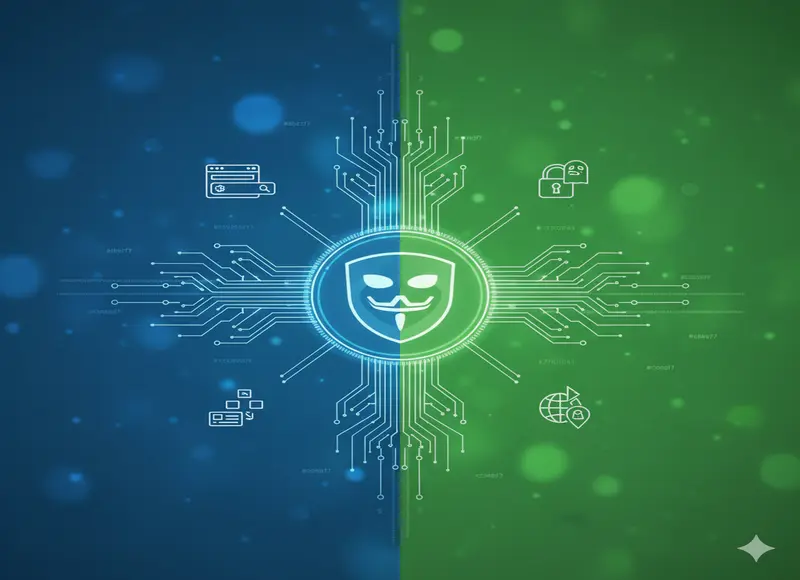Table of Contents
Worried about the security of your digital assets? This guide explores the impact of cybersecurity and provides practical strategies to keep your information safe from threats.

Cybersecurity has become indispensable as technology meshes our daily lives, making understanding and prioritizing its significance crucial.
Digital assets, ranging from personal data to critical business information, hold immense value, necessitating robust protection against cyber threats. The growing cybersecurity threat presents challenges, with sophisticated malware, phishing schemes, and stealthy insider threats lurking online. Understanding these threats enables us to build strong defense mechanisms.
According to Gartner, spending on information security and risk management will reach $188.336 billion in 2023.
Together, we will explore ways to secure our valuable digital assets, ensuring a safer online environment for all and arming ourselves with the knowledge to stay secure.
Common Cybersecurity Threats
Cyber threats lurk around every digital corner, posing significant risks to our online safety and data integrity. Understanding these threats is the first step toward strengthening our digital defenses.
Malware Attacks: Viruses, Trojans, and Ransomware
Malware, short for malicious software, is a broad term containing various digital threats. Among them are viruses, infecting and replicating within legitimate files, and Trojans, masquerading as harmless software while delivering malicious payloads.
Ransomware, on the other hand, takes extortion to new extremes by encrypting valuable data and demanding a ransom for its release. In 2022, 493.33 million ransomware attacks were detected by organizations worldwide.
Protecting Against Malware
To defend against malware, a multi-layered approach is crucial. Start by ensuring your software and operating systems are always up to date. Software companies frequently release patches to address vulnerabilities exploited by malware, making timely updates essential.
Additionally, equip your devices with reputable antivirus software that can detect and remove malware from your system. Regularly backing up your important data is another essential practice, as it can help you restore your information in the event of a ransomware attack without having to pay the extortion fee.
Phishing and Social Engineering: The Red Flags
Phishing attacks prey on human vulnerabilities rather than technical ones. Cybercriminals use deceptive emails, messages, or websites to trick individuals into revealing sensitive information, such as login credentials or financial data. Social engineering, a related tactic, manipulates human psychology to gain unauthorized access to systems or confidential information.
Phishing remains the most common cyber attack, with approximately 3.4 billion daily spam emails. Addressing vulnerabilities, such as verifying DMARC setup, helps prevent domain spoofing and reduces susceptibility to phishing attacks.
-
Staying Phish-Proof
Developing a vigilant mindset is the key to preventing phishing attempts. Be cautious of unexpected emails, especially those requesting personal or sensitive information. Check the sender's email address for suspicious domain names or misspellings that may indicate a phishing attempt.
Before clicking on any links provided in emails, hover your mouse over them to see the destination URL. If it looks suspicious, do not click on it. Enforcing two-factor authentication (2FA) provides an additional layer of security by requiring a secondary verification method for account access, making it more challenging for attackers to compromise your accounts.
Insider Threats: Addressing Risks from Within
Not all cybersecurity threats come from external sources; sometimes, they originate from within an organization. Insider threats occur when current or former employees, contractors, or business partners misuse their authorized access to compromise data, systems, or networks either intentionally or unintentionally. Implementing robust insider threat programs can help organizations detect and prevent malicious activities from within, ensuring the safety and integrity of their sensitive information.
-
Preventing Insider Threat
Effective prevention strategies begin with limiting access to sensitive data through the implementation of the principle of least privilege. This approach ensures that individuals have access only to the information necessary for their specific roles and responsibilities.
Monitoring employee activities and behaviors can also help detect unusual patterns that might indicate malicious intent. Regular cybersecurity training and awareness programs should be conducted to educate employees about the risks associated with insider threats and how they can contribute to a secure organizational environment.
Vulnerabilities and Exploits
Cyber attackers are quick to exploit vulnerabilities within software and applications.
Understanding these weaknesses and employing effective mitigation strategies is essential to safeguarding your digital assets.
Software Vulnerabilities: Patch Management and Best Practices
Software vulnerabilities are flaws or weaknesses in software code that attackers can exploit to gain unauthorized access or control over systems. Timely patch management and secure coding practices are essential in reducing the risk posed by these vulnerabilities.
-
Software Vulnerability Assessment
Regular software vulnerability assessments allow you to identify and prioritize potential weaknesses in your systems and applications. Vulnerability scanning tools can automatically analyze your software and networks, pinpointing areas that require immediate attention.
-
Patch Management Strategies
The importance of timely patching cannot be overstated. Software companies continuously release updates and patches to address known vulnerabilities and enhance security.
Execute a robust patch management strategy to promptly apply these updates, reducing the window of opportunity for attackers to exploit known weaknesses.
-
Secure Coding Practices
Secure coding is the foundation of resilient software. Developers should adhere to best practices that mitigate common vulnerabilities, such as input validation errors, buffer overflows, and SQL injection. Incorporating security into the development lifecycle can create more robust applications that are less prone to exploitation.
Zero-Day Exploits
Zero-day exploits are highly dangerous as they target undisclosed vulnerabilities in software that are yet to be patched. Since no fix is available, attackers can exploit these weaknesses with relative immunity.
-
Zero-Day Vulnerability Mitigation
Mitigating zero-day vulnerabilities requires a proactive and adaptive approach. Employ behavior-based intrusion detection systems (IDS) that can identify abnormal activities indicating a potential zero-day attack. Additionally, prioritize threat intelligence sharing with security communities to stay informed about emerging threats and possible mitigations.
-
Zero-Day Attack Defense
When faced with a zero-day attack, limiting the attack surface is critical. Employ virtual patching or web application firewalls (WAFs) to filter and monitor incoming traffic for suspicious activities. These measures can help delay or deter attackers until official patches become available.
-
Zero-Day Exploits Explained
Zero-day attackers often use sophisticated techniques to evade traditional security defenses. You can better anticipate and prepare for potential attacks by staying informed about their methods.
Web Application Security: Shielding Your Apps from Attacks
Web applications are popular targets for cybercriminals due to their prevalence and potential access to sensitive data. Prioritizing web application security is crucial to protect your business and users from exploitation.
-
Web Application Firewall (WAF)
A web application firewall (WAF) acts as a protective barrier between users and your web application. It inspects incoming traffic, filtering out malicious requests and ensuring only legitimate traffic reaches the application.
-
OWASP Top 10 Vulnerabilities
The Open Web Application Security Project (OWASP) regularly updates its top ten web application vulnerabilities list. Familiarize yourself with these common weaknesses, such as injection attacks, broken authentication, and insecure direct object references, and adopt measures to address them proactively.
-
Secure Web Development
Secure web development practices are crucial for creating resilient applications. Enforce secure coding guidelines, conduct thorough security testing, and conduct regular code reviews to identify and remediate vulnerabilities early in development.
Safeguarding Digital Assets
Safeguarding digital assets is critical to protect sensitive information from falling into the wrong hands. Let's explore three vital pillars of cybersecurity that form the bedrock of a robust defense for your digital assets.
Network Security: Building a Robust Defense
Networks serve as the backbone of digital communication, enabling the exchange of information between devices and systems. However, they also attract cyber threats seeking to exploit vulnerabilities and gain unauthorized access.
-
Firewall Protection
Firewalls act as a security gateway between your internal network and the outside world.
They analyze incoming and outgoing network traffic, filtering out potentially harmful packets while allowing legitimate data to pass through. Configuring firewalls to block suspicious activities and unauthorized access attempts creates a strong first line of defense against cyber threats.
-
Intrusion Detection Systems (IDS)
Intrusion Detection Systems (IDS) monitor network traffic for signs of malicious activity or unusual behavior. These systems use predefined rules or behavioral analysis to identify potential threats in real time.
When an anomaly is detected, the IDS alerts administrators, enabling them to take swift action before the threat escalates. Combining firewalls with IDS strengthens your network's security posture, providing better protection against diverse cyber threats.
Data Encryption: Protecting Sensitive Information
Data encryption is a vital technique used to secure sensitive information, rendering it unreadable to unauthorized users. Even if a cyber attacker manages to intercept encrypted data, they will need the correct encryption keys to be able to solve it.
-
Data Encryption Methods
Various data encryption methods exist, including symmetric and asymmetric encryption. Symmetric encryption uses a single key for encryption and decryption, while asymmetric encryption involves a pair of public and private keys. Combining both methods allows for secure data transmission and storage.
-
Encryption Algorithms
Encryption algorithms are mathematical functions that transform plaintext into ciphertext and vice versa. Robust encryption algorithms, such as AES (Advanced Encryption Standard), offer high levels of security and are widely used to protect data in various applications.
-
End-to-End Encryption
End-to-end encryption ensures that data remains encrypted throughout its entire journey, from the sender to the recipient. This technique prevents intermediaries, including service providers and network administrators, from accessing unencrypted data. End-to-end encryption is especially crucial in safeguarding sensitive communications and confidential information.
Multi-Factor Authentication (MFA): Strengthening Access Controls
Multi-Factor Authentication (MFA) adds an extra layer of security by requiring users to provide multiple forms of authentication before accessing an account or system.
-
MFA Implementation
Executing MFA involves combining at least two or more of the following authentication factors:
- something you know (e.g., a password or PIN)
- something you have (e.g., a smartphone or hardware token)
- something you are (e.g., biometric data like fingerprints or facial recognition)
MFA significantly reduces the likelihood of unauthorized access, even if an attacker manages to compromise one factor.
-
Two-Factor Authentication (2FA)
2FA, a subset of MFA, requires users to provide two different authentication factors. It is one of the most widely adopted MFA methods due to its ease of use and effectiveness. Commonly used 2FA methods include receiving a one-time code via SMS or using authentication apps like Google Authenticator.
-
Biometric Authentication
Biometric authentication utilizes unique physical or behavioral traits, such as fingerprints, iris patterns, or voice recognition, to verify a user's identity. Biometric authentication offers a high level of security as these traits are difficult to replicate and are inherently tied to the user.
Cybersecurity in the Business Environment
Businesses face increasing cyber threats that can disrupt operations, damage reputation, and compromise sensitive information. Cybersecurity governance, incident response planning, and fostering a security-conscious culture within the workforce are pivotal aspects of securing an organization against cyber attacks.
Cybersecurity Governance: The Role of Management
Effective cybersecurity governance starts at the top, with management playing a critical role in establishing a robust security framework. Comprehensive cybersecurity policies are the first step toward easing risks and protecting digital assets. These policies outline best practices, acceptable use of technology, and measures for safeguarding sensitive data.
-
Establishing a Risk Management Framework
To identify, assess, and prioritize cybersecurity risks, businesses must develop a risk management framework. This involves conducting regular risk assessments, identifying potential vulnerabilities, and proactively addressing them. By understanding the specific threats that the organization faces, management can allocate resources more efficiently to bolster defenses, often with support from an IT outsourcing company provides specialized expertise and additional security capabilities.
-
Board-Level Cybersecurity Awareness
Cybersecurity is not merely an IT concern but a crucial aspect of business strategy. Boards of directors must actively engage in cybersecurity discussions and decisions. Board-level cybersecurity awareness ensures that cybersecurity is integrated into the organization's overall risk management strategy and receives adequate resources and attention.
Incident Response: Handling Cyber Attacks Effectively
Despite robust preventive measures, no organization is immune to cyber-attacks. Hence, having a well-defined incident response plan is important for effectively managing and reducing the impact of a cyber incident.
-
Developing a Cyber Incident Response Plan
A cyber incident response plan outlines the step-by-step actions to be taken in the event of a cyber attack. It designates roles and responsibilities for the incident response team, defines communication protocols, and establishes escalation procedures. An effective plan reduces response time, minimizes damage, and aids in the recovery process.
-
Cybersecurity Incident Handling
When a cyber incident occurs, prompt and efficient handling is crucial. The incident response team must swiftly identify the nature and scope of the attack, contain its spread, and take measures to eradicate the threat. This requires a well-trained team with the skills to analyze and respond to cyber incidents. So, provide your team with resources like CompTIA SY0-701 Exam Dumps to help them more effectively handle cyber incidents.
-
Post-Incident Analysis
After an incident is resolved, conducting a post-incident analysis is essential. This process involves thoroughly examining the attack, determining its root cause, and identifying areas for improvement. The insights gained from the analysis inform future security measures and help prevent similar incidents.
Cybersecurity Training and Awareness: Certifying Your Workforce
Employees are both the first line of defense and a potential point of vulnerability in an organization's cybersecurity posture.
-
Employee Cybersecurity Training
Providing regular cybersecurity training to employees is essential in educating them about the latest threats and best practices. Training sessions should cover topics such as recognizing phishing attempts, creating strong passwords, and protecting sensitive data. Resources like CompTIA Security+ SY0-701 Practice Test Dumps can help reinforce key concepts and improve employees' understanding of cybersecurity. Employees who are knowledgeable about cybersecurity risks are better equipped to identify and report potential threats.
-
Security Awareness Programs
In addition to training, organizations should implement ongoing security awareness programs led by certified cybersecurity engineers. These engineers should hold certifications from reputable sources, such as Microsoft, and have completed relevant practice tests like the Microsoft SC-100 Practice Tests. These initiatives can include simulated phishing exercises to test employees' ability to detect and respond to phishing attempts. Regular reminders about security protocols and emerging threats also help keep cybersecurity at the forefront of employees' minds.
-
Creating a Security-Conscious Culture
A strong security-conscious culture is built on the foundation of cybersecurity awareness and shared responsibility. When employees understand the importance of cybersecurity and see it as an integral part of their daily work, they become active participants in maintaining a secure environment. Recognizing and rewarding employees for exemplary security practices further reinforces this culture.
Conclusion
We've explored the crucial importance of safeguarding our digital assets and the ever-evolving threats we face online. With the proper knowledge, you are now better prepared to protect yourself and your valuable information in our connected world.
Remember, cybersecurity is not just a set of practices; it's a mindset. Stay vigilant, keep learning about the latest threats, and apply the practical strategies we've discussed. By adopting a security-conscious culture and working together, we can create a safer digital space for everyone.
Be confident in your ability to steer the cyber landscape.









